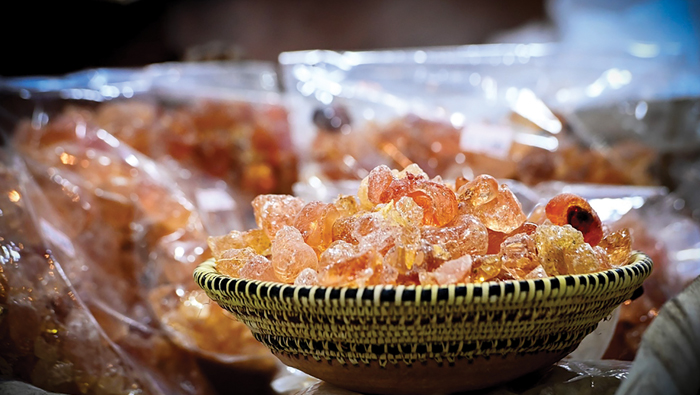Salalah: Acacia Senegal, locally called ‘Thawr’ and regionally called ‘Hashab’ is considered one of the most important trees growing in the Dhofar Governorate from which gum ‘Malakh’ is extracted. It has medicinal properties and is of high nutritional value.
This tree grows in dry and subtropical regions in the South African desert from Senegal in the west to Somalia in the east and extends up to the Arabian Peninsula to India, Pakistan and Australia.
However, this tree is not found in the Arabian Peninsula except for Dhofar Governorate as per ‘Dhofar Plants Book’ compiled by Miller and Miranda in 1988.
Modern scientific studies conducted by the researchers Said Tabuk and Abdul Aziz Al Ma’ashani under the title ‘The importance of Acacia Senegal tree in Dhofar governorate’ points to the wide existence of this tree in the Dhofar mountains with high medicinal, nutritional and economic benefits.
With respect to the historic importance of the tree, Abdul Aziz Ahmed Al Ma’ Abdul Aziz Al Ma’ashani, the researcher said that the gum was exported from Dhofar ports to global markets in huge quantities at high prices, especially in the nineteen century which indicates the existence of the tree in Dhofar mountains.
He added that the Dhofar Governorate people anciently benefited from the Acacia tree which had an impact on the economic life of the shepherds, beekeepers, farmers, merchants, fishermen and craftsmen of the region.
Eng. Said Musalam Tabuk, a researcher in agricultural engineering, said that Dhofar mountains contain forests called ‘Seasonal clouds forests’ which depend on seasonal rains occuring in the Dhofar Governorate from June end till September every year.
The Acacia tree is widely used in the Dhofar Governorate, whether its gum or its crust, which was previously used to treat wounds. Its trunk is thin but strong branches are used in making fishing cages. Due to its high nutritional value, farmers use the leaves for boosting the nutritional value of camel milk and honey is extracted from the nectar of its flowers.
Professor Loay Jamil Rashan, a researcher at Dhofar University Research Center emphasised that the tree has multiple medical benefits as documented in scientific studies. He said that its gum is used as antioxidants for treating mouth, stomach, and digestive system ulcers. In addition, it is used in some dental fillings and manufacturing of anti-caries drugs.
He added that the gum is also used in foods as a preservative and in the manufacturing of capsules, medical tablets and pharmaceutical syrups.
The diversity of the local trees and their wide spread in Dhofar mountains has contributed to the production of the finest types of honey, including gum honey. Its production starts from mid-March to the end of April each year, along with the flowering season in the beginning of the summer.
The estimated data indicated that the production of gum honey in Dhofar Governorate in 2022 was about three tonnes, at prices ranging between OMR20 and OMR35 per kg.
